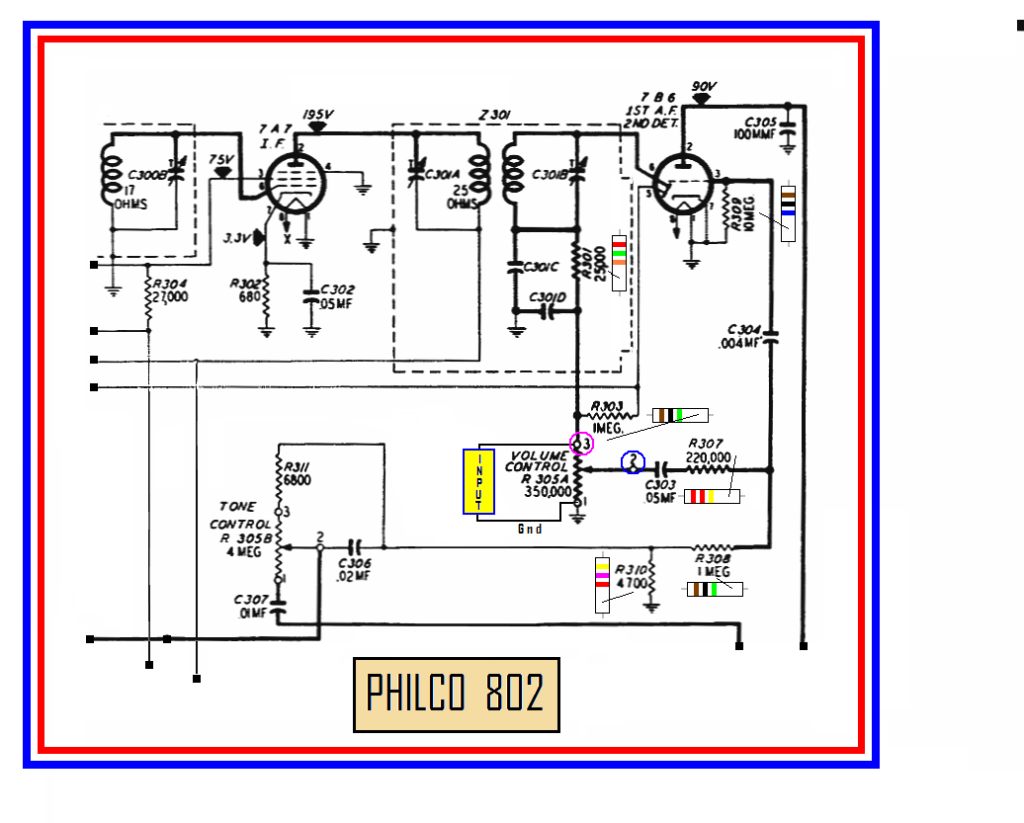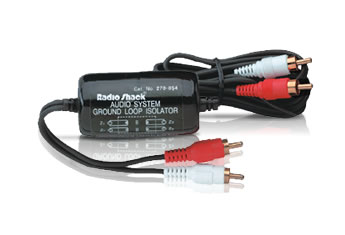:
That's the best advice I can give you. I'm sure other members can expound, (or disagree).
Terry
A VOLUME CONTROLS . . . TERMINAL IDENTIFICATION . . . AID: |
:Yes, you were close. The connection is one side of the volume control. Try one side or the other until you get the right side. Be sure to use and wire a jack so the radio will play again when the mp3 player is unplugged. Use shielded cable too.
:
:
:
: : : :  : : : : : : : : :Sir Alexander. . . . . : : :Considering that your Philco 802 is the newer one, being for use in the late 40's Plymouth and Chrysler "boxcars". : : :Consult my clarified thumbnail schematic of its relevant circuitry. : : :Looks like you initially ended up with your audio input coming in and being across the wiper of the vol-you-me control and . . . you "found ground" . . and got that last connection right ! But, with that hook up resulting in poor effectiveness in the control of the volume. : : :Instead, make your hook up as the [YELLOW] box audio source(MP-3) is shown, in its being placed across ground and the active signal of the Emm Pee- 3 player and having audio signal coming in to the #3 [FUCHSIA] circle. : : :Previously, you were feeding the signal into the #2 [BLUE] circle. : : :It's sort of a toss up in the stereo blending of two channels into mono for the input. : : :In reality that MP-3 player is a quite LOW impedance trying to go into a 100's of thousands ohms impedance of a tubes grid circuitry. : : :Why don't you initially go with the two L & R inputs coupling in thru 2 ufd capacitors and tying together and that common then going to a 1k resistor, which has its other end going into the high side of the volume control. : : :Run an evaluative listening test of the bass-treble distribution spectrum. : : :If too much treble raise the 1k in 5 K increments. :If any chance of excess bass ? . . . decrease the 1 ufd couplers values. : : :There is such a real mismatch in SS/tube interfacing, you are really just trying to get the :best compromise for your ears. : : :Remember . . . Confucius say . . . . MP-3's sure ain't CD's ! : : : : : : :  : : :Now if you happen to not intend on making your intrfacing connection right in at the vol-you-me control proper, in consulting the photo below, you can see the Motorola style antenna connector coming in, just off from bottom center, your concerned circuitry area is at the bottom center area, just to its right, and you can see the conjoined 220k res and the 1 meg unit resistors, and then over to the right, you can just barely see the edge of the 10 meg grid resistor showing itself as it is gettting connected by the lower central yellow coupling capacitor, witgh its black spaghetti going up to pin #3 of the audio preamp tube. : : : Several of those resistors, I have fully marked up on the reference thumbnail schematic. : : :There are two resistors that are going to be routed to connect to the high side of the volume control . . :R303 and R301, while the rotor of the volume control is receiving R307 thru C 303. : : : : :  : : : : : A VOLUME CONTROLS . . . TERMINAL IDENTIFICATION . . . AID: : : : : :To get your mind right with apprehending volume control mechanics, kick your perspective into FULL X-RAY VISION mode and think of the grasping of the volume control shaft and turning its control shaft CW, and in that manner you will be rotating an end wiper contact peripherally around the resistance control element. : : : That action eventually has that wiper (#2) approaching the grounded end contact (#1) and the input audio is then progressively diminished to almost zero level. : : :Should you now rotate the shaft clockwise, the rotor wiper will start coming off from a grounded condition and approaching the #3 . . . “high side” . . . terminal of the volume control and is able then to receive progressively more audio level. : : :Thassit . . . . . now in the future, if you will merely close your eyes and visualize that prior analysis, a volume controls connections . . . as per, which is which . . .will never confuse you again. : : : : : : :73's de Edd : : :  : |
:
:
:
:
:
:
:
:
:
::Yes, you were close. The connection is one side of the volume control. Try one side or the other until you get the right side. Be sure to use and wire a jack so the radio will play again when the mp3 player is unplugged. Use shielded cable too.
::
:
Once again your picture is worth my 1000 words,but do you recommend a disconnect from radio audio or just a quiet spot on the dial, when using the mp3? I did a refurb on an 802 from a '47 Plymouth here in So CA. Wouldn't it be ironic, if it was the same. Instead of an NOS vibrator (requiring opening and burnishing the points), I did the same on the original with success.
marv
:
:
:
:
:
:
:
:
:
:
:
:
:
:
:Sir Alexander. . . . .
:
:
:Considering that your Philco 802 is the newer one, being for use in the late 40's Plymouth and Chrysler "boxcars".
:
:
:Consult my clarified thumbnail schematic of its relevant circuitry.
:
:
:Looks like you initially ended up with your audio input coming in and being across the wiper of the vol-you-me control and . . . you "found ground" . . and got that last connection right ! But, with that hook up resulting in poor effectiveness in the control of the volume.
:
:
:Instead, make your hook up as the [YELLOW] box audio source(MP-3) is shown, in its being placed across ground and the active signal of the Emm Pee- 3 player and having audio signal coming in to the #3 [FUCHSIA] circle.
:
:
:Previously, you were feeding the signal into the #2 [BLUE] circle.
:
:
:It's sort of a toss up in the stereo blending of two channels into mono for the input.
:
:
:In reality that MP-3 player is a quite LOW impedance trying to go into a 100's of thousands ohms impedance of a tubes grid circuitry.
:
:
:Why don't you initially go with the two L & R inputs coupling in thru 2 ufd capacitors and tying together and that common then going to a 1k resistor, which has its other end going into the high side of the volume control.
:
:
:Run an evaluative listening test of the bass-treble distribution spectrum.
:
:
:If too much treble raise the 1k in 5 K increments.
:If any chance of excess bass ? . . . decrease the 1 ufd couplers values.
:
:
:There is such a real mismatch in SS/tube interfacing, you are really just trying to get the
:best compromise for your ears.
:
:
:Remember . . . Confucius say . . . . MP-3's sure ain't CD's !
:
:
:
:
:
:
:
:
:
:Now if you happen to not intend on making your intrfacing connection right in at the vol-you-me control proper, in consulting the photo below, you can see the Motorola style antenna connector coming in, just off from bottom center, your concerned circuitry area is at the bottom center area, just to its right, and you can see the conjoined 220k res and the 1 meg unit resistors, and then over to the right, you can just barely see the edge of the 10 meg grid resistor showing itself as it is gettting connected by the lower central yellow coupling capacitor, witgh its black spaghetti going up to pin #3 of the audio preamp tube.
:
:
: Several of those resistors, I have fully marked up on the reference thumbnail schematic.
:
:
:There are two resistors that are going to be routed to connect to the high side of the volume control . .
:R303 and R301, while the rotor of the volume control is receiving R307 thru C 303.
:
:
:
:
:
:
:
:
:
: A VOLUME CONTROLS . . . TERMINAL IDENTIFICATION . . . AID:
:
:
:
:
:To get your mind right with apprehending volume control mechanics, kick your perspective into FULL X-RAY VISION mode and think of the grasping of the volume control shaft and turning its control shaft CW, and in that manner you will be rotating an end wiper contact peripherally around the resistance control element.
:
:
: That action eventually has that wiper (#2) approaching the grounded end contact (#1) and the input audio is then progressively diminished to almost zero level.
:
:
:Should you now rotate the shaft clockwise, the rotor wiper will start coming off from a grounded condition and approaching the #3 . . . “high side” . . . terminal of the volume control and is able then to receive progressively more audio level.
:
:
:Thassit . . . . . now in the future, if you will merely close your eyes and visualize that prior analysis, a volume controls connections . . . as per, which is which . . .will never confuse you again.
:
:
:
:
:
:
:73's de Edd
:
:
:
:
:
:
:
:
:
:
:
:
:
::Yes, you were close. The connection is one side of the volume control. Try one side or the other until you get the right side. Be sure to use and wire a jack so the radio will play again when the mp3 player is unplugged. Use shielded cable too.
::
:
Without the transformer you may find inadequate gain due to the impedance mismatch.
Regarding playing the radio or the iPod, I find that it is only necessary to tune to a quiet spot on the dial and then plug in the iPod or the iPod-transformer combination, and the radio itself becomes quiet enough for good listening of the iPod. Either the iPod on its own, or through a transformer, is low enough in impedance to quiet the radio's circuitry for the most part, especially if tuned to a quiet area on the dial.
--Thomas Dermody
Many thanks for the very informative feedback. I will follow the schemtics posted by edd. The transformer idea for impediance matching sounds like a good idea, but i guess Ill first try the capasitor/resistor methode first. Ill post my results in the days to come. Thanks!!
The transformer will give you more gain and will balance the frequency spectrum more.
T/
http://www.radioshack.com/product/index.jsp?productId=2103254
This dual-channel RadioShack ( or similar) ground loop isolator ( 1:1 ratio) transformer would also certainly address the chassis/signal isolation problem?

http://www.radioshack.com/product/index.jsp?productId=2062214
:This dual-channel RadioShack ( or similar) ground loop isolator ( 1:1 ratio) transformer would also certainly address the chassis/signal isolation problem?
:

:http://www.radioshack.com/product/index.jsp?productId=2062214
:
:
Note #2: Whenever you convert a stereo signal to mono, there will be some signals out of phase. Normally this won't be noticeable, but if you hear a vocal suddenly appear low and in the background, that signal was using some sort of phasing, possibly for an effect.
Terry
(Frequency range of 300Hz-10kHz.) You additionally need to look into the disconnecting of the transformer from the tie in to the volume control / tube 1st grid circuitry, EVEN if using a DC isolative input coupling capacitor in series with the transformer secondary winding. The phono cartridges audio output was routed up to an new RCA input jack going into the high side of the volume control. No problem here, with an infinitely high cartridge Z interfacing into tube circuitry. That balancing procedure, precluded the arm swinging across the record grooves, on any other than a fast and HARD turn. And those two units additionally have the same blasé reponse as the aforementioned 1273-1380 RS output transformer: 300Hz to 5KHz response Also take note of the matching impedance of the units, being . . . way . .way . . . WAYYYYY above the MP-3 input impedance, along with the unit additionally being a 1:1 match and no upping of Z towards approaching that infinitely higher tube input impedance. |
::Hi Alexander:
::This dual-channel RadioShack ( or similar) ground loop isolator ( 1:1 ratio) transformer would also certainly address the chassis/signal isolation problem?
::
::http://www.radioshack.com/product/index.jsp?productId=2062214
::
::
:
:Note: You'll still need a "Y"adapter.
:Note #2: Whenever you convert a stereo signal to mono, there will be some signals out of phase. Normally this won't be noticeable, but if you hear a vocal suddenly appear low and in the background, that signal was using some sort of phasing, possibly for an effect.
:Terry
:
:
I restored a Mopar 802 a while back and the high side of the volume control (R305A 350k ohms marker "L" on the schematic) where you make the connection should have a wire, and 1 meg ohm resistor from 1st audio detector (Brown/black/green/silver color bands) The center (wiper) where you are now connected will have a 0.05 microfarad capacitor, but you'll have no control of the volume connected there, except at the player. You'll need a special audio jack or manual switch to interrupt the radio audio from the volume control, when using the mp3, otherwise tell Grandpa to tune to a quiet spot on the dial before using the mp3. Switching the resistor (R303) in/out for radio/mp3 operation, either with a manual switch or appropriate audio jack will do the job. Remember R303 connected for radio, disconnected for mp3. The other suggestions for caps and resistors are correct. One of Grandpa's small pill bottles can be used to contain the audio jack/manual switch, resistor and caps. A 3 conductor shielded audio cable is recommended from the pill bottle to the radio, or make your own with 3 wires and a braided shield stripped from old VCR/CATV cable. According to my schematic, doesn't appear to be any lethal DC voltages at that point, but be careful.
marv
:Hi, I have a mopar 802 car radio (by philco) that I want to convert to take an input from my Mp3 player. some one suggested I can do that by disconnecting one wire from the volume control and using it as the input lead (audio in). I was instructed to find the "high side" of the volume control by seeing which one moves the ohm meter against ground. In my case it turned out to be the center of the 3 wires on the volume control. I wired the a 1/8 phone jack to interrupt this wire and fed the mp3 signal in to it. All seems to work great, but I am not able to control the volume via the radio. Is there another way to wire in the mp3 player so I can control the volume via the radio rather then through the mp3 player. Thank you
:

